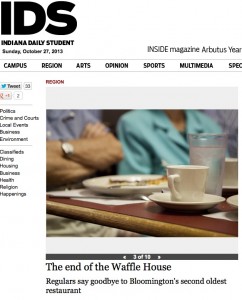A story to boost your faith in the Future of Journalism, and warm your heart
If you want to take a break from the ginned-up debates that dominate the Twitter feeds of journalists and journalism professors when they’re not being distracted by the latest shiny things from the widget mills — and God knows, we all need a break from that — I’ve got something for you. Something that can restore your faith in the future of Journalism. And I’m pretty sure that no matter what your position is on Who Is a Journalist, we can all agree Jessica Contrera is one.
I found this story via David Simpson, a journalism professor I follow on Twitter. It looks like he got it via Ryan Frank, president of the Emerald Media Group, the “modern college media organization” that replaced the former print paper at the University of Oregon. UPDATE: Frank says he saw it in a Facebook post from a U of O prof, Suzi Steffen.) People like that are part of the reason I have faith in the future of journalism, because I see some exciting innovations being tested at the college level, and professors who seem more willing than their age cohort in the newsrooms to embrace the possibilities.
But even better reason for hope is writing like this from the Indiana Daily Student:
On the last morning, before the waffle irons went cold and the pictures came down, before the lock refused to lock, before the claw crashed through the roof, the old man paced.
Tap, tap, tap. Bud Powell’s aluminum cane led the way as he circled the floor of Bloomington’s Waffle House. His Waffle House.
That Wednesday in September, the owner didn’t know what to do with himself. The smell of frying oil, the same greasy perfume that had greeted customers for 46 years, wafted into his nose as he wandered past the vinyl booths. He sat down, then stood
up again.Bud — everyone called him Bud — checked on the dwindling supply of breakfast sausage, peered into the nearly empty freezers, tried to explain to his regulars why it had to be this way.
“It’s time,” he said over and over.
And reason for hope is that Jessica didn’t just sit in the restaurant and watch — although the effort to get out of the office is more than some professional reporters I can think of could muster. She expanded what could have been just a snapshot by focusing on customers as well, and drawing out a touching subplot:
A few years before, [Dr. Dick Leyda] had rarely been seen at the Waffle House, or anywhere else, without his wife Carole. When Carole started needing a walker to get around, they still came to the restaurant. She’d order French toast and bacon from Hootie, one of their favorite waitresses.
Always French toast and bacon.
At home, Carole wasn’t so predictable. Without Dr. Leyda ever really noticing, his wife had begun filling up their children’s old bedrooms with newly bought items. Shoes still in their boxes, beautiful shirts and dresses from Talbots in the closet, never worn. Carole had never been a big shopper, and certainly not a hoarder.
“Dad,” said their daughter. “I think Mom is having problems.”
Carole was diagnosed with Alzheimer’s. Slowly, she forgot how to walk. When they went to Waffle House, Dr. Leyda brought a caregiver who could help her inside. Dr. Leyda read the menu out loud. Carole ordered French toast and bacon.
Leyda isn’t just a walk-on; this isn’t just some info Contrera got from a chat. She was smart enough to recognize the potential and follow Leyda, so she could include a scene like this, from the day after the restaurant closed:
The next morning, Dr. Leyda and Carole started the day with mini Hershey’s bars on the patio of Garden Villa. They watched the residents move slowly in and out of the rehab center doors. Some of the residents waved to Carole.
Dr. Leyda kissed her goodbye and pondered where to go next. Panera? Or Cheddar’s? McAlister’s?
Maybe Bob Evans. He liked Bob Evans. Not the food. But Hootie, his favorite old Waffle House waitress, worked there now.
This is a perfect example of what I’ve written about before, that the role of a journalist is to go where the reader couldn’t or wouldn’t. Maybe a reader could have sat in the Waffle House on its last day and seen the owner shuffling around, tapping his cane. Maybe the reader could have overheard snatches of conversation. But a journalist named Jessica Contrera did more, dug deeper. That she also had the talent to write the story with the language and pacing of literary fiction is icing on the cake — or syrup on the waffle.
I’ve quoted a lot of this story, but, please, read the whole thing. A story like this deserves to be one of the most-read on the site. And you shouldn’t miss Anna Teeter‘s photos, either.
All editors with job openings, please note.

